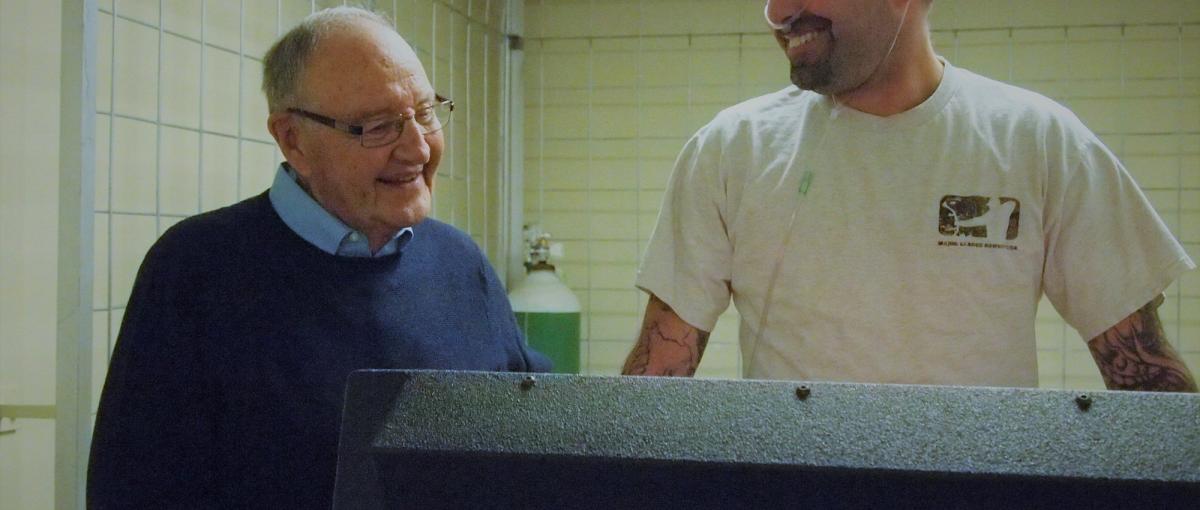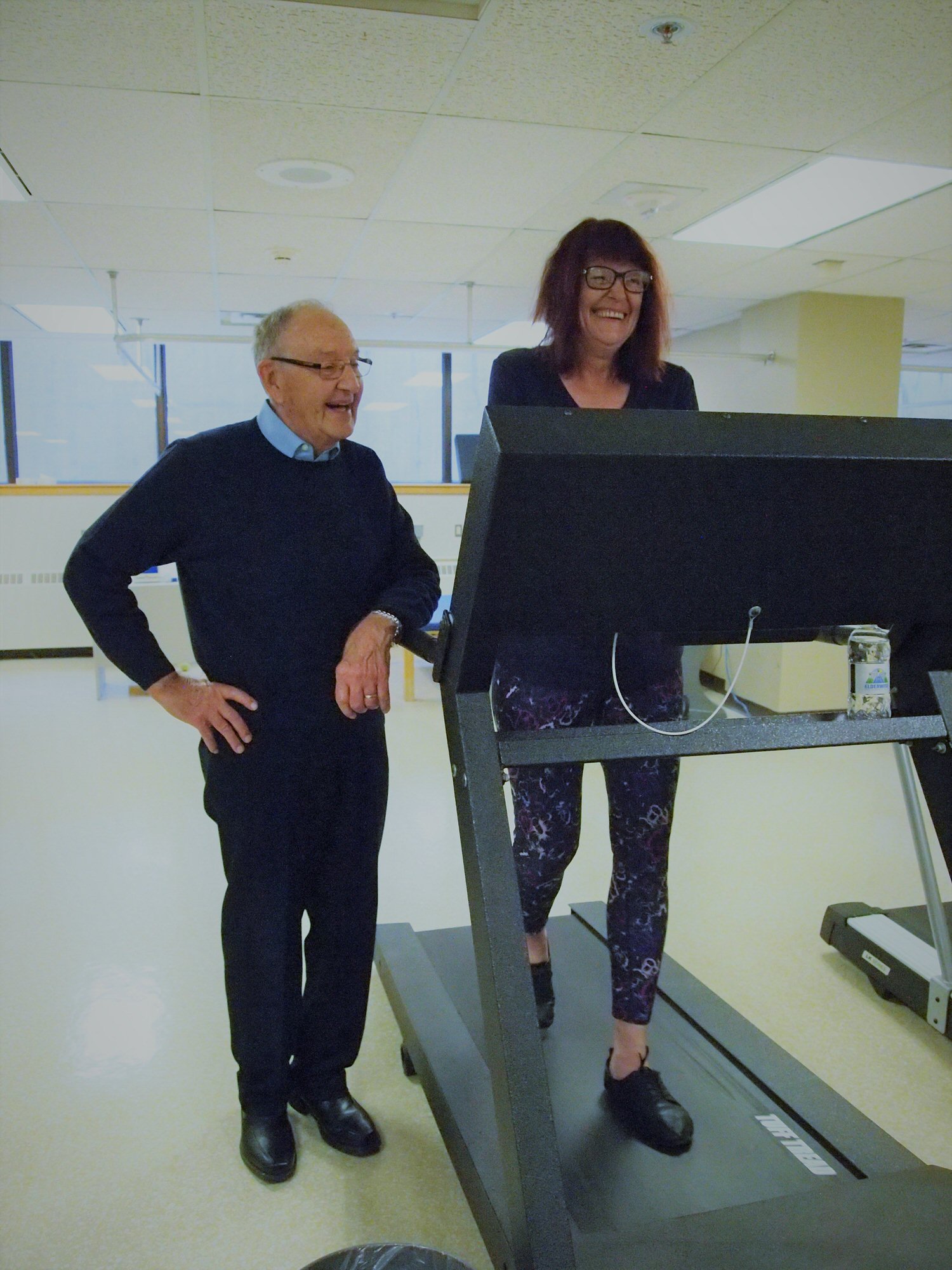Celebrating Dr. Fred MacDonald
His many accomplishments include founding Edmonton's Centre for Lung Health

November 26, 2018
By Amanda Zirk, Freelancer writer
In the 1960s, pulmonary medicine was a new specialty and only a handful of people in the United States were trained in the field. Dr. Fred MacDonald, who had left his hometown of Edmonton to study at the Mayo Clinic in Rochester, Minnesota, was one of them.
After graduation, he gave a lecture in Edmonton about lung health and soon realized the audience was eager to know more about this emerging area of care. It was spring 1968.
“I called my wife and told her, ‘We have to go back to Edmonton where there are great opportunities. I have to educate.’”
The day he started practising medicine in Edmonton, Oct. 1, 1968, was the same day the Hong Kong flu arrived. With a small team and limited resources, it was a stressful situation.
“Suddenly, I was thrust into taking care of 11 people. We needed to clear their lungs. Normally, you would just intubate and ventilate with a ventilator, but we didn’t have any of that here,” he recalls. “There was nothing, we had absolutely nothing. Ten survived.”
As an innovator of pulmonary function and rehabilitation, Fred designed the first Intensive Care unit in Edmonton in 1971 and established ventilation techniques that saved many lives. He loved teaching and practised medicine for many years until he faced a life-changing obstacle.
In 1999, while climbing a mountain, he experienced vague discomfort in his chest. Two weeks later, he was training for a cross-country skiing race and felt a "pop."

Dr. MacDonald and Donna Rahmoun, Breathe Easy Program participant, share a laugh.
Thinking nothing of it, he got ready for work, drove to the hospital and went for breakfast with colleagues before rounds. They could tell something was off.
“One of my young residents took my blood pressure and it was low. She got the cardiologist from next door, who detected I had a heart murmur,” says Fred. “I was rushed to the Cardiac Care unit with a ruptured cardiac septum and then transferred to the U of A.”
In surgery, doctors—many of whom he knew and had trained found two holes in Fred’s heart, but were unable to close them and couldn’t stop the bleeding.
“They went to my wife and family to tell them I probably wouldn’t survive without a heart transplant. It would have been a really difficult conversation,” explains Fred. “I was closely monitored in hospital. Then, 10 days later, a heart became available and it was a match!”
He recovered in a few months, but was not able to return to practising medicine because of the risk of infection.
Not ready to retire, he put all his effort into rehabilitation therapy and the Centre for Lung Health, which he had started at the Edmonton General Continuing Care Centre in 1992. With a limited budget and few staff, creativity was required.
A respiratory medicine colleague found monitors and bikes in the hospital basement to conduct cardiopulmonary tests. Together, he and Fred would assess patients’ oxygen flow and CO2 output, and measure the effectiveness of a patient’s heart or lungs.
They started the Breathe Easy Program with six patients who visited the Edmonton General three times a week, over six weeks. Patients were educated about anatomy and physiology, exercise, travel, appropriate medications, oxygen and more. The team retested patients at the end of the program to measure improvement. Three of those initial six patients are still alive; some are still on oxygen, others are not.
Finding adequate funding was always difficult for the centre. The C.O.L.D. Club was formed and held casinos and galas as fundraisers, but cardiopulmonary equipment was expensive.
“Patients were a marginalized group of people. They couldn’t pay for services because they couldn’t work,” says Fred. “But the centre changed their lives, so even they would donate.”
Throughout the ‘90s, Fred led the pulmonary rehabilitation program and helped introduce remote patient care via computer service, known as telehealth. Rural patients could drive to an approved centre in their local area, sparing them the need to drive all the way to Edmonton to connect with an expert in the field. It was a true breakthrough for the centre.
“The first telehealth patient lived close to Grande Prairie. This man would drive 60 miles in 30 below and he never missed an appointment. I was so proud of him, and he did so well,” says Fred with a smile. “He phoned all the farmers in the area because they had the same problems from having inhaled grain dust, and they became new program participants.”
Fred and his colleague Dr. Mike Stickland conducted research to compare the outcomes of Edmonton versus rural program participants to determine whether location affected success rates. The study showed that, although rural participants were not meeting with their doctor face to face, they were more fit and more disciplined than their urban counterparts.
At this time, the centre was only 60 per cent funded. On average, the centre was helping more than 400 patients a year. Fred applied for grants and continued to host fundraisers. The centre’s good work was recognized by the head of Alberta Health Services (AHS). She and her team toured the facility. Today, the centre is fully funded and continues running the programs Fred started all those years ago. He retired in 2014 but continues to visit the staff and program participants regularly.
In November 2018, Fred was recognized for his many contributions with Edmonton’s Salute to Excellence Citation and Performance Award.
“The award is for the department, not for me. This is for the great work they do. When you have the capacity to change someone’s life, that’s the reward you get.”
The Centre for Lung Health set the Canadian standard for rehab and the program has led the way in treating chronic lung disease. The team provides education for the University of Alberta faculties that need mandatory training in their programs to maintain accreditation. The same applies to NAIT, which sends respiratory students through the program. Research continues to be the centre’s strong point, with many publications.